Stephen Mortlock casts an eye back over the history of alcohol, from drunken monkeys to eating dried bull penis as a hangover cure.
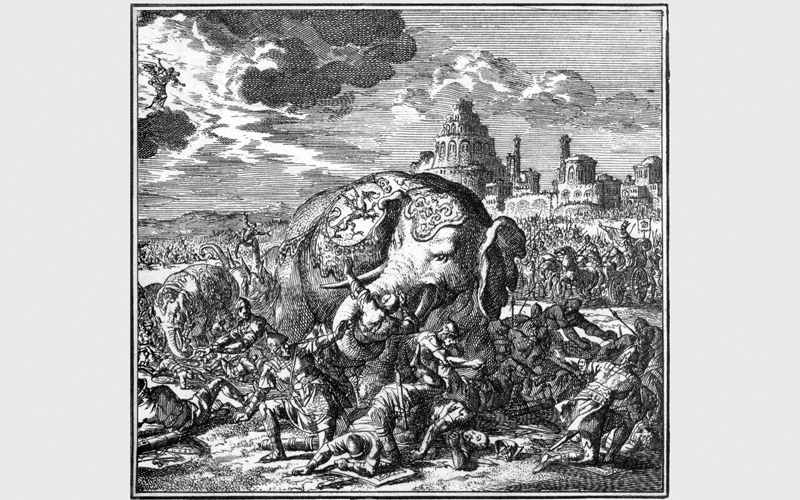
Evidence suggests that animals will seek out both alcoholic and hallucinogenic plants to relieve stress and pain. Jaguars have been seen gnawing at the bitter Banisteriopsis caapi vine, which is an ingredient of the psychoactive brew “ayahuasca”, used by some Amazonian shamans as a hallucinogen, while reindeer will eat Amanita muscaria mushrooms to get high. Rather disturbingly, local people would collect and drink reindeer urine to achieve the same effect, although this practice is decreasing. Scientists have found that animals that primarily consume fruits, vegetables and nectar (frugivores) need alcohol (and primarily the ethanol molecule) as a low-level but routine component of their diet. Ethanol is a macronutrient energy source, capable of providing calories for all the essential biological activities of animals: replication, function, and maintenance of individual cells; energy for physical work; and thermogenesis. Potentially adaptive animal behaviours associated with the natural occurrence of ethanol include the olfactory use of ethanol plumes to localise fruit crops, the use of ethanol as an appetitive stimulant to facilitate rapid consumption of transient nutritional resources, and the physiological exploitation of the caloric benefits of ethanol. Researchers found that spider monkeys (Ateles geoffroyi) sniffed and took a bite out of ripe fruits from the jobo tree (Spondias mombin), which routinely had alcohol concentrations of between 1% and 2%. This fruit was a major component of the monkey’s diet. Urine collected from some of the monkeys showed secondary metabolites of ethanol, but they were probably not getting drunk, because their stomachs were filling with fruit before they reached inebriating levels. This, however, formed the basis of Dudley’s “drunken monkey” hypothesis. It has also been believed, based on travellers’ tales, that elephants would become intoxicated from eating fermented marula fruit (Sclerocarya birrea). Books have been written about the phenomenon and eyewitness accounts of allegedly intoxicated pachyderms have even been made. Certainly, in the Third Book of Maccabees, King Ptolemy IV Philopator (Pharaoh of Egypt) attempted to have the Jewish people trampled by a horde of drunken elephants, when he was denied entry into the Temple in Jerusalem. He ordered his soldiers to make his herd of war elephants drunk on wine and incense and then drive them to trample the assembled crowd. Just when the situation appeared hopeless, the elephants instead turned upon the soldiers. Researchers at the University of Bristol have shown, however, that like the monkeys, elephants would need to ingest large quantities of the fruit to reach intoxication levels. It seems that people just want to believe in drunken elephants. However, at the end of the wet season in Western Australia, red-collared lorikeets (Trichoglossus rubritorquis) are routinely found stumbling around, falling off their perches and showing signs not dissimilar to human drunkenness. It has been noted that: “They can act like a drunken person, they stumble around, are uncoordinated, they chatter incessantly and chase their reflections in windows.” It is believed that they drink fermented nectar from Schotia brachypetala flowers but after a night in lock-up and a good breakfast of sweetened porridge and fresh fruit they are released. Unfortunately, for some birds the hangovers don’t go away easily, and it can take months to recover while others have died. In 2012, a large number of cedar waxwings (Bombycilla cedrorum) were found dead after colliding with solid objects such as windows, skylights, walls and fences. Necropsy examination revealed that all the birds had engorged themselves with over-ripe berries of the Brazilian pepper tree (Schinus terebinthifolius) and ethanol was detected at levels of 260–1000 ppm in the intestinal contents and liver. The cause of death in these birds was reported as trauma from collisions when flying under the influence of ethanol.
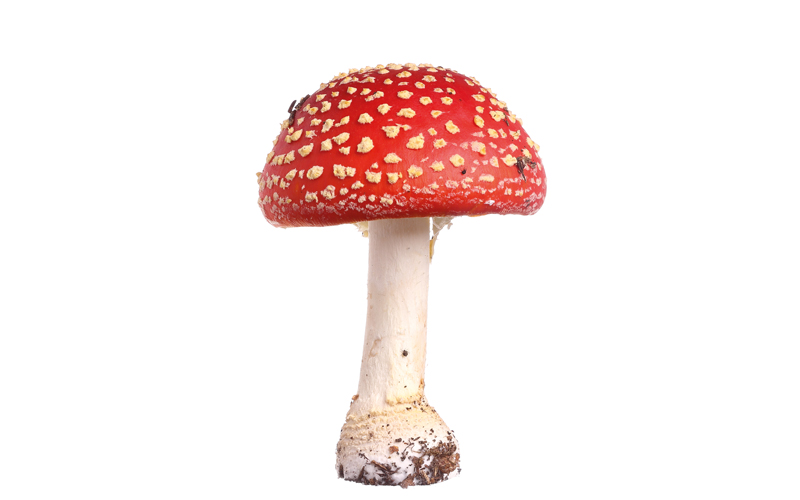
“Red-collared lorikeets (Trichoglossus rubritorquis) are routinely found stumbling around, falling off their perches and showing signs not dissimilar to human drunkenness.”
Humans first began intentional fermentation during the Meso–Neolithic transitional period broadly coincident with the domestication of crops, and ethanol consumption has correspondingly been viewed as a recent phenomenon relative to the origin of our species. The oldest verifiable brewery has been found in a prehistoric burial site in a cave near Haifa in modern-day Israel. Researchers have found residue of 13,000-year-old beer that they think might have been used for ritual feasts to honour the dead. The traces of a wheat-and-barley-based alcohol were found in stone mortars carved into the cave floor.
Chemical analysis of jars from the Neolithic village Jiahu in the Henan province of northern China from around 7000 BC revealed traces of a mixed fermented beverage. According to a study published in the Proceedings of the National Academy of Sciences in December 2004, chemical analysis of the residue confirmed that a fermented drink made of grapes, hawthorn berries, honey and rice was being produced in 7000–6650 BC. This is approximately the time when barley beer and grape wine were beginning to be made in the Middle East. In Mesopotamia, beer was a daily drink as well as a beverage for celebration; they even had a beer goddess “Ninkasi” (associated with its production, consumption, and effects – both positive and negative). While we don’t know how alcoholic an ordinary brew really was, cuneiform tablets record the joy and conviviality of drinking. That sounds familiar, but unlike today, companions sometimes sipped with long straws from communal beer jars.
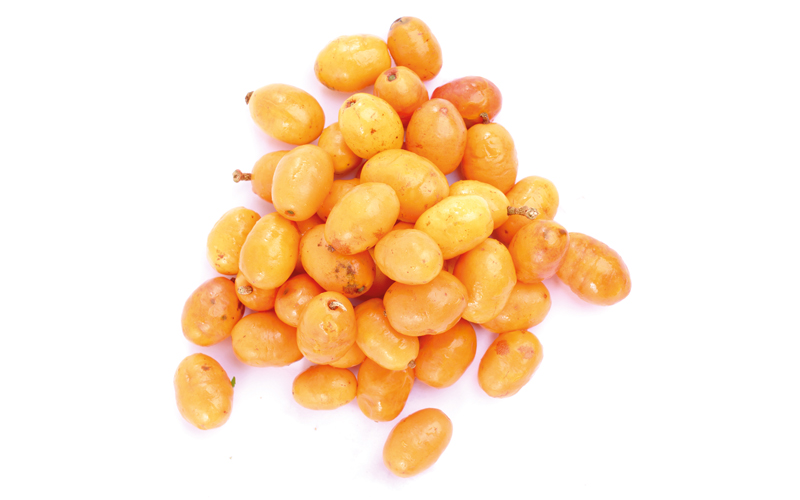
Wine, beer and mead
In the Early Middle Ages beer and wine were primarily brewed in monasteries, and on a smaller scale in individual households. In England, the Low Countries, northern Germany, Poland and Scandinavia, beer was consumed daily by people of all social classes and age groups. Where grapes were cultivated, across Southern Europe and the Western Mediterranean, wine was a common table beverage but for some nobility in these areas it was still common to drink beer or ale. This might have been a consequence of the Norman conquest and the travelling of nobles between France and England; one French variant of ale was described in the 14th century cookbook Le Menagier de Paris and called “godale” (most likely a direct borrowing from the English “good ale”) and was made from barley and spelt, but without hops (see box, right). By the High Middle Ages breweries in the fledgling medieval towns began to take over production of beer, especially in northern Germany.
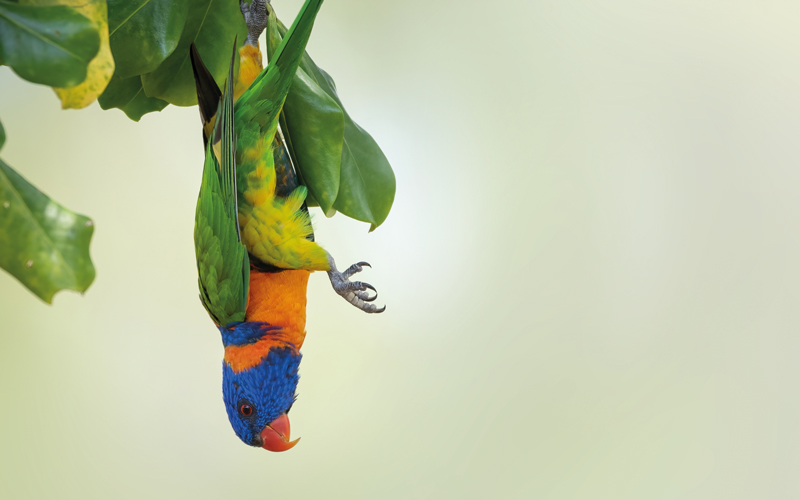
Viniculture (cultivating grapes specifically for wine) dates back to the Neolithic era. And fermentation jars from about 6000 years ago have been found in caves in the south Caucasus country of Armenia along with grape seeds, the remains of pressed grapes and dozens of dried vines. Archaeologists from the University of California also found a shallow basin, measuring about 1m (3ft) across, which they believed was a wine press where people pressed the grapes with their feet; this was positioned to drain the juice into a deep vat. By the fifth century BC, ancient Rome flourished in wine production. The techniques used throughout Rome had developed from earlier methods promulgated by the Greeks. Many grape varieties first planted by the Greeks were introduced to various regions throughout Rome. Archaeological evidence shows that humans have cultivated, harvested and blended grapes for the production of wine for thousands of years. Contemporary records show that the Phoenicians used specific processes for winemaking between 1200 and 900 BC. By medieval times, Catholic monks performed many winemaking tasks.
The Parisian Household Book
Le Ménagier de Paris; or The Parisian Household Book is a French medieval guidebook from 1393 on a woman’s proper behaviour in marriage and running a household. It includes sexual advice, recipes and gardening tips. Written in the (fictional) voice of an elderly husband addressing his younger wife, the text offers a rare insight into late medieval ideas of gender, household, and marriage. Important for its language and combination of prose and poetry, the book’s central theme is wifely obedience.
Wine was commonly drunk and was also regarded as the most prestigious and healthy choice. According to Galen’s dietetics it was considered hot and dry but these qualities were moderated when wine was watered down. Unlike water or beer, which were considered cold and moist, consumption of wine in moderation (especially red wine) was, among other things, believed to aid digestion, generate good blood and brighten the mood.
Another of the drinks commonly associated with the Middle Ages is mead; this is a honey wine made from honey and water via fermentation with yeast. Mead is known from many sources of ancient history throughout Europe, Africa and Asia, although archaeological evidence of it is ambiguous. Certainly, there are many songs and poems about mead. The Kanu y med, or “Song of Mead”, was written by the Brythonic speaking (Celtic) bard Taliesin some time around 550 AD. The legendary drinking, feasting, and boasting of warriors in the mead hall is echoed in the mead hall Dyn Eidyn (modern day Edinburgh), and in the epic poem Y Gododdin, both dated around AD 700. In the Old English epic poem Beowulf, the Danish warriors drank honey mead. Mead was the historical beverage par excellence and commonly brewed by the Germanic tribes in Northern Europe. Some monasteries kept up the old traditions of meadmaking as a by-product of beekeeping, especially in areas where grapes could not be grown.
Although the technique of distillation was known by both the ancient Greeks and Romans, the technique was “lost” and it was not practised again on a major scale in Europe until some time around the 12th century, when Arabic innovations in the field of alcohol combined with water-cooled glass alembics were introduced. Distillation was believed by medieval scholars to produce the essence of the liquid being purified, and the term aqua vitae (“water of life”) was used as a generic term for all kinds of distillates. The early use of various distillates, alcoholic or not, was varied, but it was primarily culinary or medicinal; grape syrup mixed with sugar and spices was prescribed for a variety of ailments, and rose water was used as a perfume and cooking ingredient and for handwashing. Alcoholic distillates were also occasionally used to create dazzling, fire-breathing entremets (a type of entertainment dish after a course) by soaking a piece of cotton in spirits. It would then be placed in the mouth of the stuffed, cooked and occasionally redressed animals, and lit just before presenting the creation.

Chemical reaction in the body
Now the science bit.
After consuming an alcoholic drink, the liver springs into action and, put simply, the enzymes alcohol dehydrogenase (ADH), cytochrome P450 2E1 (CYP2E1), and catalase swiftly metabolise the alcohol into acetaldehyde, which is toxic, a carcinogen and contributes to the behavioural effects including loss of judgement, decreased concentration, impaired coordination, and the symptoms of a hangover. From there the liver enzyme aldehyde dehydrogenase (ALDH) metabolises the acetaldehyde into acetate, a less toxic compound but which can still cross the blood–brain barrier where it impacts gamma-aminobutyric acid (GABA), an inhibitory transmitter, which can lead to impaired motor function. Finally, the acetate breaks down into water and carbon dioxide (Figure 1). The two main steps of ethanol metabolism require energy in the form of NAD, namely the NAD+-linked oxidation of ethanol to acetaldehyde and the NAD+-linked oxidation of acetaldehyde to acetate, which causes an increased concentration of the reduced pyridine coenzyme NADH but reduces the levels of cytoplasmic and mitochondrial NAD so inhibits gluconeogenesis and fatty acid oxidation. Some of the acetate produced in the liver is further oxidised through the citric acid cycle, but this can stall due to the overabundance of NAD under alcoholic conditions.
These pathways of ethanol metabolism have detrimental consequences that contribute to the tissue damage and diseases seen in alcoholic patients. These consequences include: oxygen deficits in the liver; interaction between alcohol metabolism by-products and other cell components, resulting in the formation of harmful compounds; formation of highly reactive oxygen-containing molecules (i.e. reactive oxygen species) that can damage other cell components; and changes in the ratio of NADH to NAD+.
Social issues
Alcohol and the adverse effects of its excessive consumption (see box, right) were well recognised and documented in ancient history, especially in Biblical writings. In Isaiah 5:11: “Woe to those who rise early in the morning to run after their drinks, who stay up late at night till they are inflamed with wine.” The New Testament is similar to the Old Testament in terms of some fundamental attitudes towards alcohol. St Paul, for example, in the spirit of the Old Testament, unequivocally condemns drunkenness but recommends the consumption of wine in moderate amounts. Nevertheless, there are significant differences in emphasis between the two documents. Certainly, Noah planted a vineyard and incurred God’s wrath after he became inebriated on the wine he produced from the grapes. While in the New Testament, Jesus miraculously made copious amounts of wine at the wedding at Cana (John 2). Wine is referred to as God’s gift in six of the books from the Old Testament, and no such description is offered in the New Testament. Total abstention seems acceptable only under exceptional circumstances in the Old Testament, while it is implicitly extolled through the exemplary role of John the Baptist in the New Testament. Finally, penalties for drunkards, including loss of salvation, are proportionally more frequent and comprehensive in the New Testament.
In the Middle Ages, alcoholism was widely spread in all classes of society, but predominated among the clergy and among university students (the students were taught Theology, Law, Medicine or the Arts), despite protests from the church. St Bede the Venerable (672–735 AD) declared that “And not only the laity (ordinary people) guilty of these things, but even the Lord’s flock and their pastors. Giving themselves up to drunkenness, hatred, quarrels, and violence.” Bede believed that people had already compromised their own spiritual immune systems with drink when plague and other physical diseases struck them down. The medieval publican had a bad reputation for fraud and dishonesty, while the tavern was often regarded as a place of ill-repute and because of this there was a taxation on drink, reduction in the hours of sale and the number of taverns and other restrictions introduced during this time.
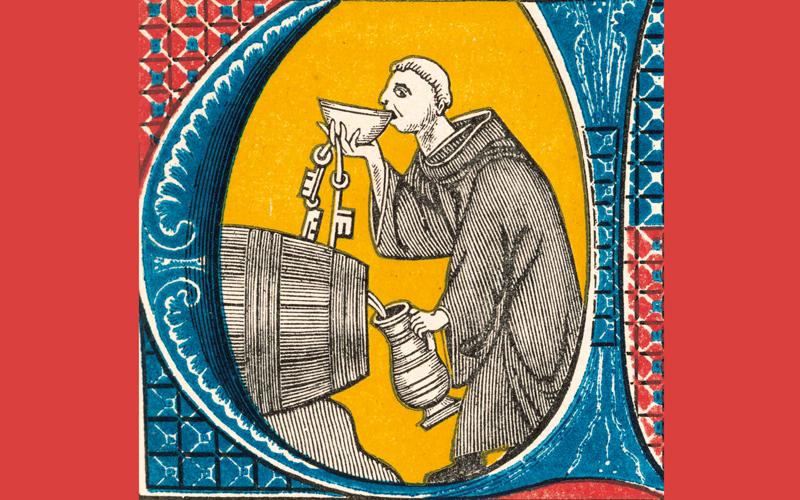
“Alcoholism was widely spread in all classes of society, but predominated among the clergy and students”
Shakespeare knew all about drinking; he liked a drink himself. Indeed, it is believed that he died of alcohol poisoning after a “merry” drinking session in Stratford with the playwrights Ben Jonson (1572–1637) and Michael Drayton (1563–1631), although this is a matter of conjecture as there was also an epidemic of “fever” sweeping through Stratford at the time of his death. He would not have been surprised at the antics in the centre of every British town and city on Friday and Saturday nights, as Iago says to Cassio in Othello: “They [the English] are most potent in potting. Your Dane, your German, and your swag-bellied Hollander – drink, ho! – are nothing to your English.” Shakespeare knew that drink had some virtues because it gives courage to Falstaff (Henry IV Parts 1 & 2), who remarked “doth any deed of courage; and this valour comes of sherris (sherry)”. But alcohol can also cause hallucinations. In The Tempest, while drinking, Stephano hears a voice (that of the invisible Ariel) accusing him of lying. Trinculo says to him: “Out o’ your wits, and hearing too? A pox on your bottle! This can sack and drinking do.” The preacher Richard Harris in the early 1600s observed that: “[O]ne drunkard hath tongue enough for twenty folke, and hath somewhat to say to every question and person; he is then a good astronomer, logician, philosopher and what not? A constable, justice, preacher, counsellor, a king. What cannot he doe? What doth he not know and what will he not say?”
By the time of the Industrial Revolution (1760–1840) factory bosses felt that the use of alcohol was a problem – it created an obstacle to industrial work and discipline, and was conducive to absenteeism, accidents, inefficiency and insubordination. Previously, in pre-industrial Europe, drinking on the job, discussion, drink, and quite often song were all part of the workday especially in an agrarian society. Alcohol acted as a stimulant, a thirst quencher and helped to facilitate social exchanges. When an apprentice, yeoman or journeyman made progress in his profession, all workers enjoyed an informal break where alcohol was served to celebrate, with the master craftsman often providing the refreshment. After industrialisation, although the workplace required new customs and traditions many workers wanted to continue with the previous traditions and use alcohol for its social and physiological benefits. They believed that “they cannot perform their usual work without alcohol”. Braum noted: “The less free time the factory worker had for the satisfaction of his social needs, the more he was forced to seek an alternative during working hours. Under the force of these circumstances, the factory workshop itself became an important arena of social life.” But establishments such as public houses, gin palaces or beer shops enabled large numbers of working people to escape from the tyranny of Victorian capitalism and basically exploitative labour. Such places provided the working class with an alternative environment where they could enjoy and relax. Drinking places and drinking habits were part of everyday life; more especially they were synonymous with sociability.

Working-class drinking was often described as humdrum and routine while in contrast, the drinking culture of the higher classes involved a bit more show and spectacle. For many middle- and upper-class men and women, drinking wine with meals formed an intrinsic part of the daily routine much like the dinner beer of the working classes. The consumption of alcohol was governed by the rules of social etiquette to demonstrate and reinforce social class and gender values. Mrs Beeton (1836– 1865) noted in her Book of Household Management that “a gentleman honoured by sitting on the right of the hostess, may politely inquire if she will do him the honour of taking wine with him.”
Within middle- and upper-class homes, purchasing, serving and consuming good-quality wines and spirits were key ways to demonstrate levels of cultural capital and good taste, so much that Dickens believed that “without a good wine, a dinner is worthless.”
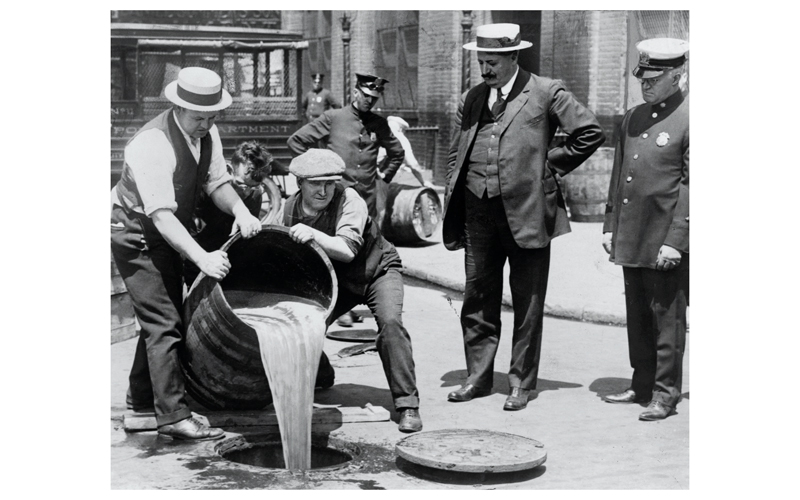
“In 1920 prohibition came into effect, with a national ban on the production, transportation and sale of alcoholic drinks”
During this time between 1880 and 1914, however, an alternative to the blissful domestic arrangements began to flourish that provided gentlemen with private spaces for socialising, networking, dining, drinking and entertaining – the “Gentlemen’s Club”. There were 75 clubs located in the West End of London alone and all exclusively reserved for men.
The most popular clubs with the largest numbers of members were political and military clubs but other clubs were formed through mutual interests in art, literature, sport, travel and school or university affiliation. And of course, they had a wine committee to ensure only the best-quality wines and drink were served. It was noted that Sir Arthur Conan Doyle, a member of both the Athenaeum and the Reform Clubs, invited 11 guests to dinner in the Athenaeum where they consumed 2 bottles of Pale East India Sherry, 2 bottles of Rudenheimer, 1 bottle of Chateau Palmer, 8 bottles of Moet Chandon, 2 bottles of Port, various glasses of brandy and whisky, with cigars and cigarettes. The privacy and protection afforded by the home and by gentlemen’s clubs did not diminish the conspicuous consumption of alcohol by the middle and upper classes, but it did largely evade the spectre of the drunkard stumbling out of an East End public house.
The temperance movement and prohibition
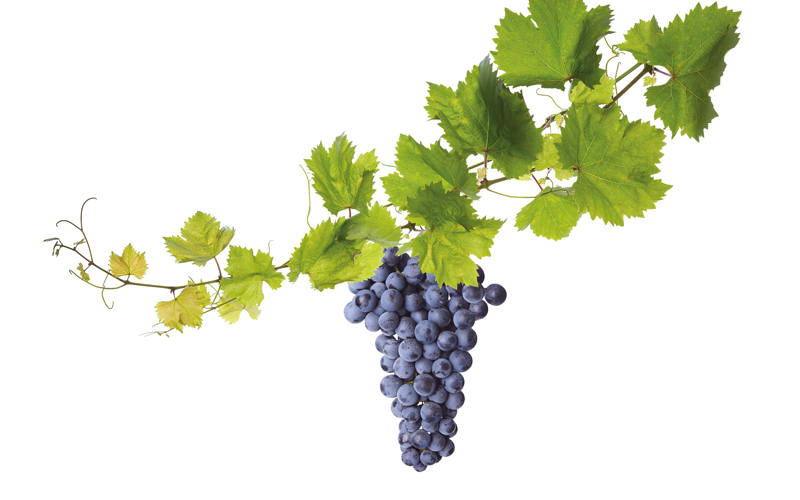
In the 18th century, Britain was gripped by gin consumption. Changes in the law made it easier to produce and sell gin; coupled with heavy taxes on imported spirits and beers, gin became the drink of choice for many, especially in London. Not surprisingly, this rampant consumption led to social issues, including increased crime, poverty and mortality rates. One of the most tragic stories from the time was that of Judith Defour, who was hanged in 1734 for murdering her young daughter, Mary, so she could use her clothing for gin money. Her testimony read that she “sold the Coat and Stay for a Shilling, the Petticoat and Stockings for a Groat (a four pence coin) and all for a Quartern of Gin.” The case drew widespread attention and highlighted the devastating societal impact of rampant alcohol consumption and addiction. As 19th-century urban Britain continued to grapple with widespread drinking, the British Temperance Movement emerged in response to the detrimental effects on families and society, with demands for social, political and economic reform.
And in 1832 Joseph Livesey and six other men stood outside a Preston public house and made a pledge to abstain from hard spirits, thus marking the birth of the first organised temperance advocacy in Britain, the Preston Temperance Society.
By WWI strong measures by the government to control alcohol consumption were introduced to fight the enemy within. The prime minister Lloyd George (1863–1945) remarked: “We are fighting Germans, Austrians and drink.” To counter this the Central Control Board effectively nationalised the brewery and pub industry in areas where the efficiency of munitions factories might have been damaged by drunkenness among workers. Across the country, taxes were increased, strengths reduced, licences restricted and “responsible pub management” (including facilities for women) encouraged. Beer consumption per head by 1918 was half pre-war levels, and despite the return of troops continued to decline for the next 15 years, prompting a Royal Commission in 1931 to declare that “drunkenness has gone out of fashion”.
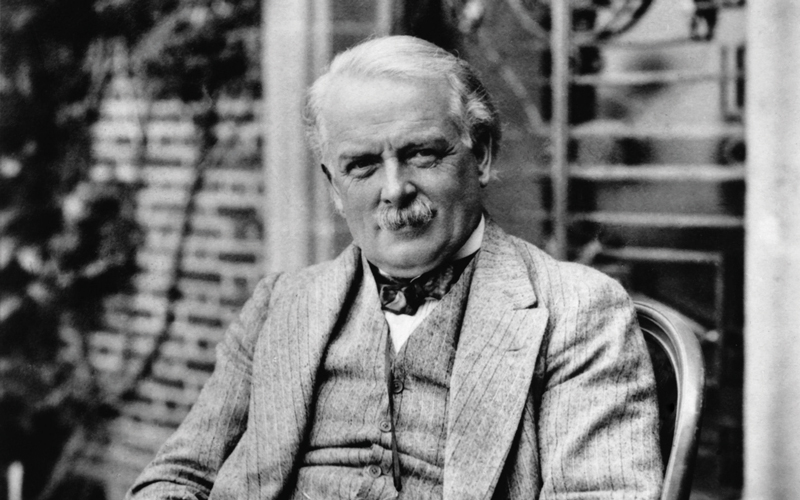
The American Society of Temperance, created in 1826 by clergymen, spread the gospel of antidrink through the network of the ministry, inaugurated by crusades of revivalistic fervour. By 1835, 1.5 million Americans had vowed never to consume spirits again. With the approach of the Civil War the temperance movement was now essentially a prohibition movement and it diversified and fragmented depending on members’ varying commitment to the cause. Northern temperance societies were militantly antislavery and inundated subscribers to southern temperance journals with abolitionist literature. The temperance groups increasingly pressed for the mandatory prohibition of alcohol rather than for voluntary abstinence and in 1869 the national Prohibition Party was formed. Although its platform was built around the destruction of the saloon – “that manufacturer of madmen and murderers … and millions of rum-ruined and unutterably wretched homes”– the party from the very beginning aligned itself with a range of other causes. During its first national campaign in 1872, not only did it endorse the direct election of United States senators, but it also was in the vanguard of advocacy for complete and unrestricted suffrage for women and full, adequately protected voting rights for all citizens. A great wave of prohibition sentiment led directly to the adoption of the 18th Amendment, which was put before Congress in 1917, ratified in January 1919 and in 1920 prohibition came into effect, with a national ban on the production, transportation and of alcoholic drinks, which remained in place until 1933.
In response, the British brewing industry stepped up its campaign against the temperance movement and argued against the introduction of restrictions on the sale of alcohol in the UK. Although the temperance movement met with local success in parts of Britain, it failed to impose national prohibition, and disappeared as a significant force following the WWI.
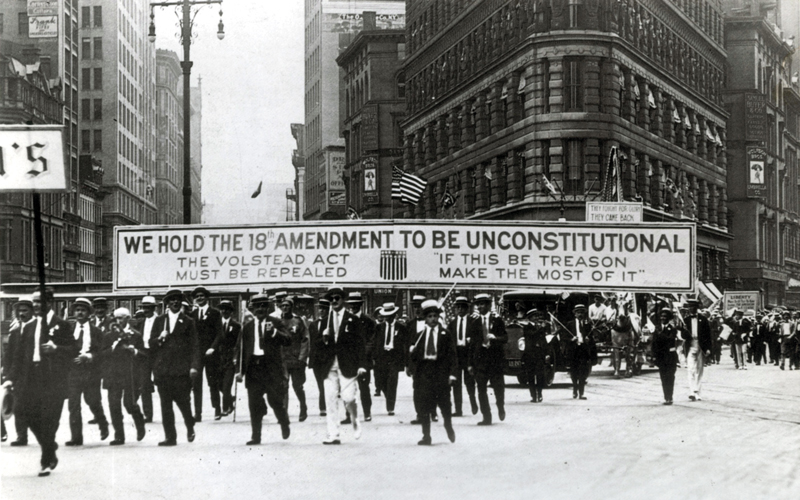
The hangover cure
There is, however, still the conflict of views as to whether alcohol is the attractive elixir or a dangerous poison. Since the invention of fermented beverages, curing the dreadful aftermath of over-imbibing has been one of humanity’s morning-after quests. Interestingly, the word “hangover” is a relatively new term and has only been around since the 1900s. Prior to that, it was known by several other names: morning fog, gallon-distemper, bottle ache, blue-devils, jim-jams, crop-sick, black dog and bust-head.
Ancient Greeks believed that the sufferer should eat sheep lungs and two owl eggs to cure such a hangover, a cure tweaked by the Roman Gaius Plinius Secundus (Pliny the Elder), who suggested raw owl or a fried canary. Sicilians recommended dried bull penis while the Mongolians preferred tomato juice with pickled sheep eyes. When the ancient Assyrians felt the painful after-effects of excess merriment, they consumed a mixture of ground birds’ beaks and myrrh. The Greeks recommended wearing a careful selection of plants on your head to keep drunkenness at bay including ivy, laurel, and asphodel (the asphodel plant is in the genus Asphodelus and in Greek legend was one of the plants connected with the dead), which were already used for medicinal purposes. Some believed you should only drink alcohol after a frog has drowned in it; perhaps this was a common occurrence in ancient times! The Romans suggested eating cabbage and Brussel sprouts, both raw and cooked. Anacharsis (sixth century BC), a wise man from Scythia, gave us the following pearl of wisdom: “The vine bears three kinds of grapes: the first of pleasure, the next of intoxication, and the third of disgust.”
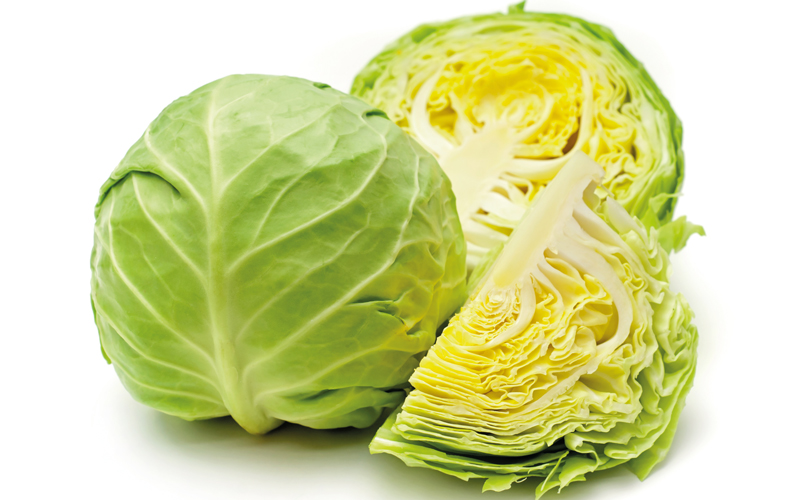
“The Romans suggested eating cabbage and Brussel sprouts, both raw and cooked”
In England during the Middle Ages, raw eel with some ground bitter almonds was prescribed to cure a hangover, stemming from the belief that the eels would soak up the remaining alcohol in your system. John of Gaddesden (1280–1361), the English court physician in his medical treatise, the Rosa Medicinae, recommended a testicle treatment: “If anyone hath drunk too much, if it be a man the testicles should be washed with salt and vinegar, and if it be a woman, the breasts, also let them eat the leaf or the stalk or the juice of a cabbage with sugar.” In Ireland, one hangover cure was to throw some oats in ice cold spring water and quaff it down. Don’t fancy this type of porridge, then why not bury yourself up to your neck in wet sand – a steadfast cure for the morning fog.
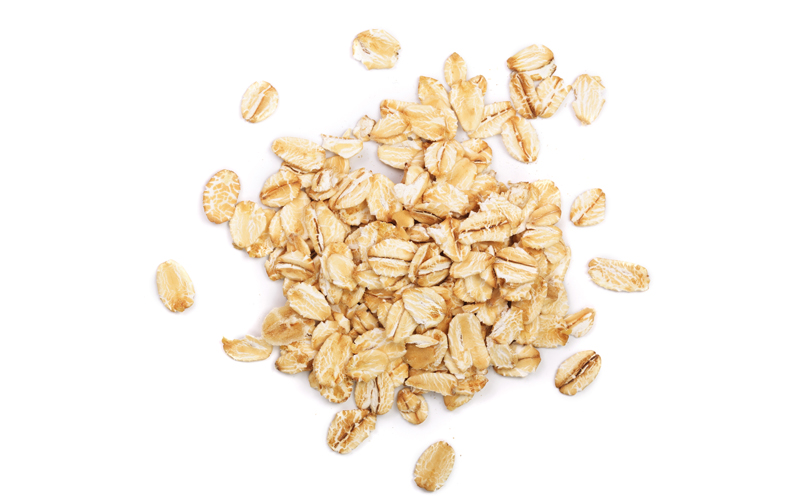
In 1845, the Italian self-taught herbalist Bernardino Branca developed a cure-all he called Fernet – containing myrrh, rhubarb, chamomile, aloe, cardamom, peppermint oil and a host of other ingredients including grape-infused spirits and some opiates. Branca used the drink as a general pick-me-up and to treat a number of ailments, including worms, for any unspecified fever, for cholera, menstrual pain and hangovers. Fernet-Branca, as it is called today, is still available, although it’s now quite opiate-free.
The story has it that in 1894, Lemuel Benedict (1846–1943) a retired Wall Street stockbroker, flamboyant man-about-town and doyen of fashion went into the Waldorf Hotel hoping to find a cure for his morning hangover. He ordered buttered toast, poached eggs, crisp bacon, and a hooker of hollandaise”. Oscar Tschirky, the maître d’hôtel, was so impressed with the dish that he put it on the breakfast and luncheon menus but substituted ham for the bacon and a toasted English muffin for the toast.
So Eggs Benedict was born, one of the many supposed cures for a hangover. Not surprisingly over the years many other claims and counterclaims have been published as to the origins of the dish.
In 2013, Chinese researchers from Sun Yat-sen University studied the effects of 57 different herbal and carbonated drinks on the enzymes that break down and rid the body of acetaldehyde and acetate. They discovered that some drinks that contain hemp seeds, particularly a herbal infusion called “Huo ma ren” (made from the flowering buds of Cannabis sativa), increased ADH levels. This has been shown to accelerate the breakdown of the alcohol initially, but can also inhibit the enzyme responsible for getting rid of the acetate. The study showed that although green teas are rich in antioxidants, they “seriously prohibit” the metabolism of alcohol. The researchers wrote it’s better not to drink tea products during or after excessive alcohol consumption.
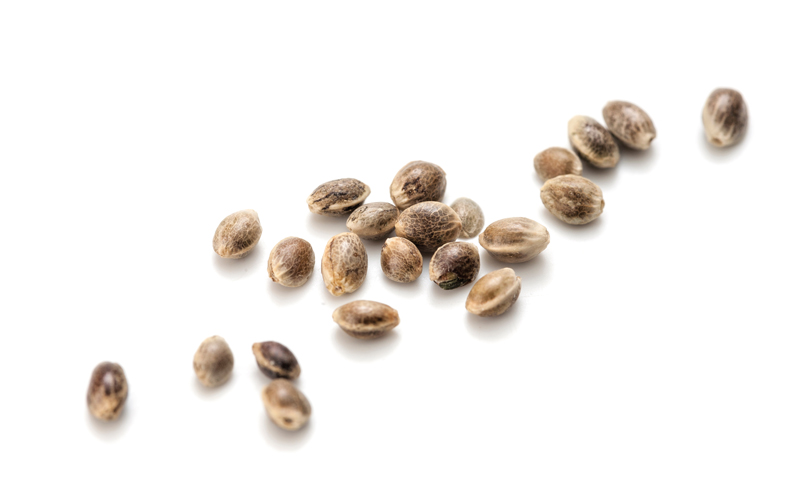
“Sicilians recommended dried bull penis while the Mongolians preferred tomato juice with pickled sheep’s eyes”
And of course, there is always the “hair of the dog” (in Hungarian this is “kutyaharapást szőrével” or “you may cure the dog’s bite with its fur”) as people will try to combat their hangover with more alcohol the following morning. According to a theory, many hangover symptoms are correlated with the breakdown not of ethanol, but methanol, a common congener (a substance, other than the desired type of alcohol, ethanol, produced during fermentation in many alcoholic drinks). Given the choice, the enzymes that break down alcohol go for ethanol rather than methanol, so flush a little more ethanol through your system when the hangover kicks in and you’ll find some temporary relief, but it just delays the inevitable! Like its ethanol partner, methanol is metabolised by the same enzymes as ethanol. The only difference is that this time formaldehyde is formed instead of acetaldehyde. But this too can produce the hangover symptoms.
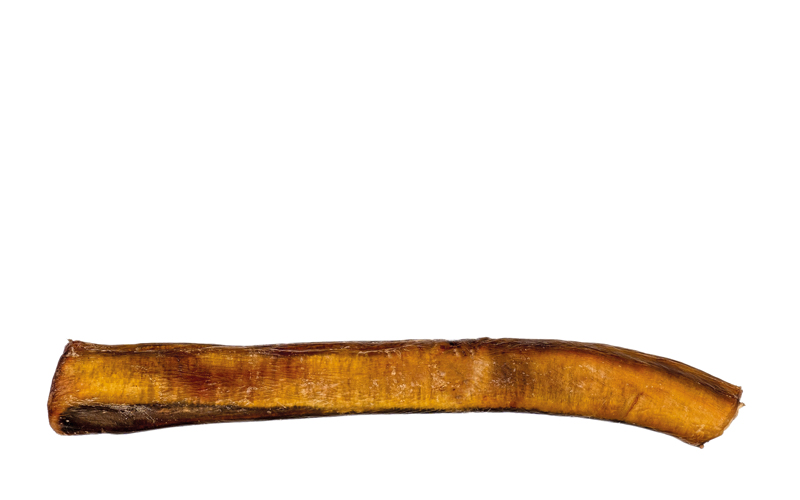
A study showed that treatment with 4-methylpyrazole (Fomepizole), a medication used to treat methanol and ethylene glycol poisoning blocks the breakdown of methanol, which can eliminate the symptoms. There is also a prescription drug called disulfiram (Antabuse), which is given to alcoholics, and contains the enzyme aldehyde dehydrogenase. This enzyme degrades acetaldehyde, forcing acetaldehyde into blood circulation, causing the drinker to get sick enough to give up alcohol. Unfortunately, the drug is often abandoned before the alcohol.
Conclusions
Alcoholic beverages may have been the most popular and common daily drinks throughout most of Western civilisation’s history as an indispensable source of fluids and calories. And in a world of contaminated and dangerous water supplies, alcohol truly earned the title granted it in the Middle Ages: aqua vitae, the “water of life.” Aqua vitae in its alcoholic forms was certainly praised by medieval physicians. In 1309 Arnaldus of Villanova wrote that it “prolongs good health, dissipates superfluous humours, reanimates the heart and maintains youth.” Although, prior to this in 1256, the Sienese physician Aldobrandino described beer in the following way:
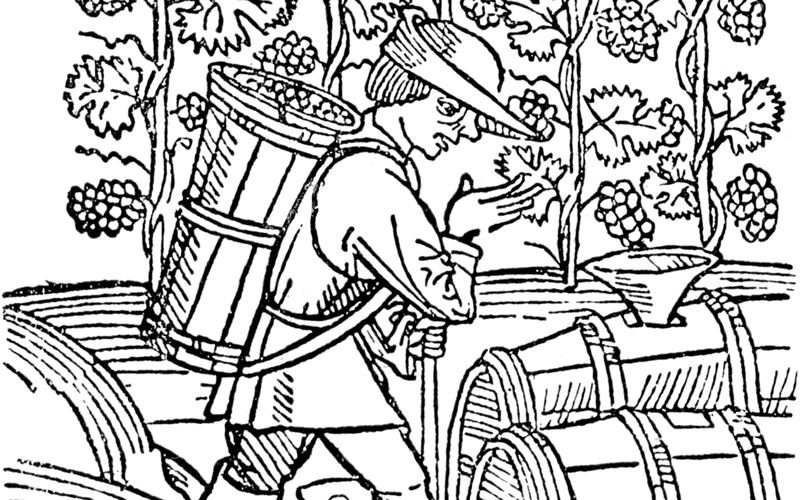
“But from whichever it is made, whether from oats, barley or wheat, it harms the head and the stomach, it causes bad breath and ruins the teeth, it fills the stomach with bad fumes, and as a result anyone who drinks it along with wine becomes drunk quickly; but it does have the property of facilitating urination and makes one’s flesh white and smooth.”
Dr Stephen Mortlock is still semi-retired and working as a bank biomedical scientist at Frimley Park Hospital in the microbiology department. Stephen would like to thank Marcial Navarro and all the microbiology staff at Frimley Park Hospital for continuing to put up with him.
Image Credit | iStock | Alamy | Shutterstock
References
Paton A. Alcohol in the body. BMJ. 2005 Jan 8;330(7482):85-7.
Vallee BL. The Conflicted History of Alcohol in Western Civilization. Scientific American (2015)
Vaillant GE, Hiller-Sturmhöfel S. The Natural History of Alcoholism. Alcohol Health Res World. 1996;20(3):152-161. PMID: 31798117; PMCID: PMC6876506.
Alcohol Through the Ages. Nature 131, 810 (1933). https://doi.org/10.1038/131810a0
McGovern, Patrick E.; Zhang, Juzhong; Tang, Jigen; Zhang, Zhiqing; Hall, Gretchen R.; Moreau, Robert A.; Nuñez, Alberto; Butrym, Eric D.; Richards, Michael P.; Wang, Chen-shan; Cheng, Guangsheng; Zhao, Zhijun; Wang, Changsui (21 December 2004). "Fermented beverages of pre- and proto-historic China". Proceedings of the National Academy of Sciences of the United States of America. 101 (51): 17593–17598
'World's oldest brewery' found in cave in Israel, say researchers". BBC News. 15 September 2018. Retrieved 26 January 2021
Morris S, Humphreys D, Reynolds D. Myth, marula, and elephant: an assessment of voluntary ethanol intoxication of the African elephant (Loxodonta africana) following feeding on the fruit of the marula tree (Sclerocarya birrea). Physiol Biochem Zool. 2006 Mar-Apr;79(2):363-9.
Makopa TP, Modikwe G, Vrhovsek U, Lotti C, Sampaio JP, Zhou N. The marula and elephant intoxication myth: assessing the biodiversity of fermenting yeasts associated with marula fruits (Sclerocarya birrea). FEMS Microbes. 2023 Oct 6;4:xtad018.
Kinde, H., Foate, E., Beeler, E. et al. Strong circumstantial evidence for ethanol toxicosis in Cedar Waxwings (Bombycilla cedrorum). J Ornithol 153, 995–998 (2012). https://doi.org/10.1007/s10336-012-0858-7
Fitzgerald SD, Sullivan JM, Everson RJ. Suspected ethanol toxicosis in two wild cedar waxwings. Avian Dis. 1990 Apr-Jun;34(2):488-90. PMID: 2369387.
Dudley R, Maro A. Human Evolution and Dietary Ethanol. Nutrients. 2021 Jul 15;13(7):2419. doi: 10.3390/nu13072419. PMID: 34371928; PMCID: PMC8308604.
Dudley R. Evolutionary origins of human alcoholism in primate frugivory. Q Rev Biol. 2000 Mar;75(1):3-15. doi: 10.1086/393255. PMID: 10721531.
Dudley R. Fermenting fruit and the historical ecology of ethanol ingestion: is alcoholism in modern humans an evolutionary hangover? Addiction. 2002 Apr;97(4):381-8. doi: 10.1046/j.1360-0443.2002.00002.x. PMID: 11964055
Dudley R. ‘The Drunken Monkey: Why We Drink and Abuse Alcohol’, University of California Press, 2014.
Warner J. Shifting categories of the social harms associated with alcohol: examples from late medieval and early modern England. Am J Public Health. 1997 Nov;87(11):1788-97. doi: 10.2105/ajph.87.11.1788. PMID: 9366636; PMCID: PMC1381162.
Warner J. Historical perspectives on the shifting boundaries around youth and alcohol. The example of pre-industrial England, 1350-1750. Addiction. 1998 May;93(5):641-57. doi: 10.1046/j.1360-0443.1998.9356412.x. PMID: 9692265.
Khaderi SA. Introduction: Alcohol and Alcoholism. Clin Liver Dis. 2019 Feb;23(1):1-10. doi: 10.1016/j.cld.2018.09.009. PMID: 30454824.
Sharma HK, Tripathi BM, Pelto PJ. The evolution of alcohol use in India. AIDS Behav. 2010 Aug;14 Suppl 1:S8-17. doi: 10.1007/s10461-010-9727-7. PMID: 20571859.
Al Ansari M, Dawson A, Conigrave K. Alcohol: from Mesopotamia to Modern Iraq. J Ethn Subst Abuse. 2021 Jul-Sep;20(3):343-365. doi: 10.1080/15332640.2019.1657541. Epub 2019 Sep 18. PMID: 31530161.
Rabinowitch IM. ALCOHOL. Can Med Assoc J. 1933 Jun;28(6):587-98. PMID: 20319125; PMCID: PMC402869.
Zakhari S. Overview: how is alcohol metabolized by the body? Alcohol Res Health. 2006;29(4):245-54. PMID: 17718403; PMCID: PMC6527027.
Abel L. The sure proof. Wine is sure proof that God loves us and wants us to be happy. J Ark Med Soc. 1996 Dec;93(7):316-8. PMID: 8990761.
Pani G, Koch OR, Galeotti T. Molecular and genetic aspects of ethanol in human diet: a nutrient or a toxicant? Genes Nutr. 2010 Jun;5(2):97-9. doi: 10.1007/s12263-010-0169-7. Epub 2010 Feb 20. PMID: 20606810; PMCID: PMC2885164.
Wilson DF and Matschinsky FM. ‘Ethanol metabolism: The good, the bad, and the ugly.’ Medical Hypotheses Volume 140, July 2020, 109638
Linda F. Bisson, Christian E. Butzke, Susan E. Ebeler. ‘The Role of Moderate Ethanol Consumption in Health and Human Nutrition.’ Am J Enol Vitic. 1995 46:449-462 ; DOI: 10.5344/ajev.1995.46.4.449
Suter PM, Shutz YS and Jequier E. ‘The effect of Ethanol on Fat Storage in Healthy Subjects.’ N Engl J Med. 1992; 326: 983-987
Arlie Loughnan. ‘Since the days of Noah’: the Law of Intoxicated Offending.’ Manifest Madness: Mental Incapacity in the Criminal Law. Oxford University Press 2012. Published 2012 by Oxford University Press.
Dalrymple T. ‘Shakespeare on alcohol.’ BMJ 2011;342:d1789
Seller SC. Alcohol abuse in the New Testament. Alcohol Alcohol. 1987;22(1):83-90. PMID: 3297079.
Altschuler EL. Societal consequences of Noah’s alcohol misuse. S Afr Med J. 2005;95:820.
Breen N. Irish influence on the temperance movement. Br J Gen Pract. 2012 Oct;62(603):538. doi: 10.3399/bjgp12X656874. PMID: 23265212; PMCID: PMC3459759.
Edwards G. Thomas Trotter's 'Essay on Drunkenness' appraised. Addiction. 2012 Sep;107(9):1562-79. doi: 10.1111/j.1360-0443.2012.03890.x. Epub 2012 May 8. PMID: 22563912.
Warner J, Riviere J, Carson J. On wit, irony, and living with imperfection: how Britain said no to abstinence. Am J Public Health. 2008 May;98(5):814-22
Al Ansari M, Dawson A, Conigrave K. Alcohol: from Mesopotamia to Modern Iraq. J Ethn Subst Abuse. 2021 Jul-Sep;20(3):343-365. doi: 10.1080/15332640.2019.1657541. Epub 2019 Sep 18. PMID: 31530161.
Lieber CS. Pathogenesis and early diagnosis of alcoholic liver injury. N Engl J Med. 1978 Apr 20;298(16):888-93. doi: 10.1056/NEJM197804202981606. PMID: 634332.
Greenaway JR. The "improved" public house, 1870-1950: the key to civilized drinking or the primrose path to drunkenness? Addiction. 1998 Feb;93(2):173-81. doi: 10.1046/j.1360-0443.1998.9321733.x. PMID: 9624720.
Harris R. The Drunkards Cup. London, England: Felix Kyngston for Thomas Man; 1619.
Edwards G. The trouble with drink: why ideas matter. Addiction. 2010 May;105(5):797-804. doi: 10.1111/j.1360-0443.2009.02773.x. Epub 2009 Dec 18. PMID: 20039858.
Lober D. ‘Wine & Viniculture in Roman and Medieval History.’ The Vine Daily (2015).
Blocker JS Jr. Did prohibition really work? Alcohol prohibition as a public health innovation. Am J Public Health. 2006 Feb;96(2):233-43. doi: 10.2105/AJPH.2005.065409. Epub 2005 Dec 27. PMID: 16380559; PMCID: PMC1470475.
Hands T. Drinking in Victorian and Edwardian Britain: Beyond the Spectre of the Drunkard [Internet]. Cham (CH): Palgrave Macmillan; 2018. Chapter 12, The Drinking Cultures of the Higher Classes. 2018 Jun 19. from: https://www.ncbi.nlm.nih.gov/books/NBK524991/ doi: 10.1007/978-3-319-92964-4_12
Beeton I. 1861. The Book of Household Management: London: S. O. Beeton: p. 8.
Davidoff L. 1986. The Best Circles: London: Croom Helm Ltd.: p. 39.
Dickens C. 1853. Household Words, Volume VIII: www.djo.org.uk/household-words/volume-viii-p: accessed 15/09/2014.
Verster JC, Berthélemy O. Consumer satisfaction and efficacy of the hangover cure after-effect(©). Adv Prev Med. 2012;2012:617942. doi: 10.1155/2012/617942. Epub 2012 Jul 18. PMID: 22852090; PMCID: PMC3407600.
Kucher, Michael, ‘The Use of Water and its Regulation in Medieval Siena’, Journal of Urban History, Vol.31:4 (2005)
Suddath C. ‘A Brief history of hangovers.’ Time Magazine (2009)
Yeomans, H. (2011). What Did the British Temperance Movement Accomplish? Attitudes to Alcohol, the Law and Moral Regulation. Sociology, 45(1), 38-53.
Smith, Michael A. “Social Usages of the Public Drinking House: Changing Aspects of Class and Leisure.” The British Journal of Sociology, vol. 34, no. 3, 1983, pp. 367–385.
Marie Elisabeth Lebon. The Temperance Movement and the Working Class in Nineteenth Century British Society. Humanities and Social Sciences. 2020. ffdumas-03264376
Swift R, Davidson D. Alcohol hangover: mechanisms and mediators. Alcohol Health Res World. 1998;22(1):54-60.
